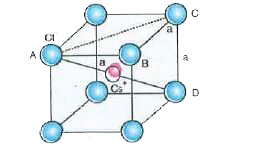CsCl has cubic structure of ions in which Cs+ ion is present in the body -centre of the cube. If density is 3.99 g cm−3 :
(a) Calculate the length of the edge of a unit cell.
(b) What is the distance between Cs+ and Cl− ions ?
(c) What is the radius of Cs+ ion if the radius of Cl− ion is 180 pm ?
Video Solution
Text Solution
The unit cell of CsCl has cubic arrangement of Cl− ions and Cs+ ion is present in the body centre of the cube. Therefore, the unit cell contains one Cs+ and one Cl− ion or one CsCl unit, i.e, Z = 1.
Molar mass of CsCl,M=133+35.5=168.5gmol−1
Density, ρ=Z×Ma3×NA
3.99gcm−3=1×(168.5gmol−1)a3×(6.022×1023mol−1)
a3=1×(168.5gmol−1)(3.99gcm−3)×(6.022×1023mol−1)
=7.02×10−23cm3
(i) Let length of the edge of unit cell = a
a3=7.02×10−23cm3=70.2×10−24cm3
a=(70.2×10−24cm)1/3
=4.12×10−8cm=412 pm
(ii) As shown in the figure, Cs+ ion is present in the centre of unit cell and is in contact with 8Cl− ions at the corners. It is clear that the length of the body diagonal is equal to twice the distance between centre of Cs+ and centre of Cl− ion. The body diagonal can also be calculated as :
If length of unit cell edge is a, then face diagonal AC, is
AC=√AB2+BC2=√a2+a2=√2a
The body diagonal AD is :
AD=√AC2+CD2=√2a2+a2=√3a.

Now,
2 (Distance between Cs+andC,−)=√3a
or Distance between Cs+andCl−=√32a
=√32×412 pm=1.732×206 pm
=356.8 pm.
(iii) Let the radius of Cl− be r(Cl−) so that
r(Cs+)+r(Cl−)=356.8 pm
r(Cl−)=356.8−180=176.8 pm.
|
Updated on:21/07/2023
Topper's Solved these Questions
- BOOK - MODERN PUBLICATIONCHAPTER - SOLID STATEEXERCISE - COMPETITION FILE - OBJECTIVE TYPE QUESTIONS (A. MULTIPLE CHOICE QUESTIONS)30videos
SOLID STATE
- BOOK - MODERN PUBLICATIONCHAPTER - SOLID STATEEXERCISE - COMPETITION FILE - OBJECTIVE TYPE QUESTIONS (B. MULTIPLE CHOICE QUESTIONS)18videos
SOLID STATE
- BOOK - MODERN PUBLICATIONCHAPTER - SOLID STATEEXERCISE - REVISION EXERCISES (NUMERICAL PROBLEMS)(CBSE Qs)6videos
SOLID STATE
- BOOK - MODERN PUBLICATIONCHAPTER - POLYMERSEXERCISE - Competition file (OBJECTIVE TYPE QUESTIONS) (C. MULTIPLE CHOICE QUESTIONS)(Integer Type Questions)6videos
POLYMERS
- BOOK - MODERN PUBLICATIONCHAPTER - SOLUTIONSEXERCISE - UNIT PRACTICE TEST14videos
SOLUTIONS
Similar Questions
Knowledge Check
- Question 1 - Select One
The CsCl has cubic structure of Cl− ions in which Cs+ in which Cs+ ion is present in the body centre of the cube. It density is 3.99gcm−3.
Then length of the edge of unit cell is :A312pmB412pmC436pmD536pm - Question 2 - Select One
The CsCl has cubic structure of Cl− ions in which Cs+ in which Cs+ ion is present in the body centre of the cube. It density is 3.99gcm−3.
The radius of Cs+ ion if the radius of Cl− ion is 180pm is :A180.6pmB276.8p mC176.8pmD280.6pm - Question 3 - Select One
The distance between Na+ andCI− ion ion NaCI is 281 pm. What is the edge length of the cube
A1405 pmB562 pmC843 pmD281 pm
The density of NH4Cl is 1.534gcm−3. It crystallizes in the CsCl lattice.
a. Calculate the length of the length of the edge of NH4Cl unit cell.
b. Calculate the shortest distance between a NH⊕4 ion and a Clɵ ion.
c. Calculate the radius of NH⊕4 ion if the radius of the Clɵ ion is 181 pmView SolutionIf the distance between Na+ and Cl− ions in NaCl crystal is 'a' pm, the edge length of the unit cell is
View SolutionIf a is the edge length of unit cell of sodium chloride, the distance between the nearest Na+andCl− ions is
View SolutionCsBr has BCC structure. The length of its side is 4.3Å. The minimum distance between Cs+ and Br− ion will be
View SolutionThe distance between Na+ and Cl− ions in NaCl with a density 3.165gcm−3 is
View Solution

